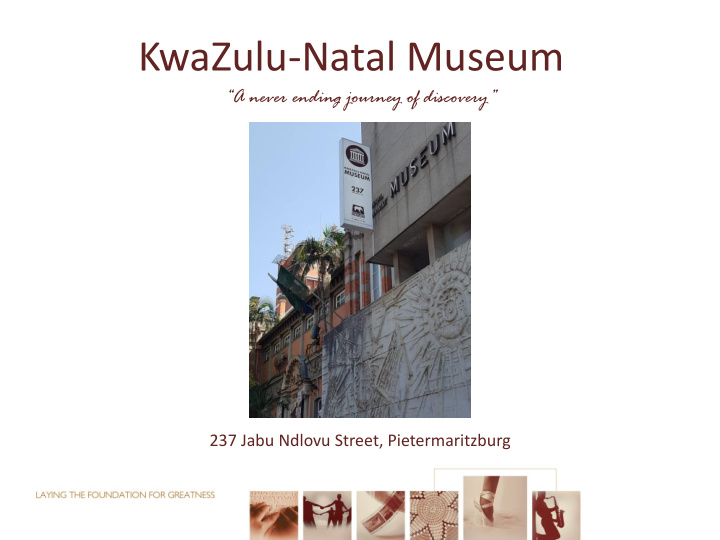



KwaZulu-Natal Museum “A never ending journey of discovery” 237 Jabu Ndlovu Street, Pietermaritzburg 1
BACKGROUND • Established by the Natal Society Library in 1897 • Opened its doors to the public in 1904 • KwaZulu-Natal Museum is a schedule 3A public entity. • The Museum was declared in terms of the Cultural Institutions Act, 1998 (Act No. 118 of 1998). • The Museum receives institutional transfers from the Department of Arts and Culture to finance its operations and address its infrastructural needs. • The entity discharges its obligation through three programs, namely Administration, Business Development and Public Engagement 3 2
MISSION The KwaZulu-Natal Museum is dedicated to serving the people of South Africa by interpreting material evidence of the cultural and natural world, in order to increase knowledge, understanding and appreciation of the nation’s wealth of history and biodiversity. VISION To position the KwaZulu-Natal Museum as a leading heritage institution in South Africa. 3
KEY PROGRAMS • PROGRAMME 1: ADMINISTRATION • PROGRAMME 2: BUSINESS DEVELOPMENT • PROGRAMME 3: PUBLIC ENGAGEMENT 1 4
RESEARCH DEPARTMENTS Biodiversity Scientific conservation publications National and Popular international publications RESEARCH initiatives OUTPUTS Leadership in Community Science out-reach Source of expert Human capacity knowledge development Applied Research / Educational Cultural Resource Collaboration with National enrichment Management & International Institutions 5
ALIGNMENT WITH DAC GOALS Strategic outcome DAC strategic objective KZN museum strategic goal Output for 2017/18 oriented goal A transformed and To develop, protect and To develop and preserve the Collaborate in collections with Durban productive ACH promote cultural and museum collections that Natural Sciences Museum sector. creative sector. reflects the nations diversity New collection areas, diversity Promote Research Capacity 90 % heritage assets databased Editorial of research journals 10 papers published & 12 presentations Membership of the NRF’s Natural Sciences Collections Facility Project To account for heritage Staff appointed for Electronic Asset assets in the care of the Registers Museum Grant Thornton to verify and valuate assets (R3m) Interns (5) for databasing. 7 6
Collections: Mollusca • > 150 000 catalogue entries • ~ 600 000 specimens 7
Collections: Mollusca • > 150 000 catalogue entries • ~ 600 000 specimens • Main challenges: – Climate control – Wet collection storage – Sample backlog 8
Collections: Mollusca • > 150 000 catalogue entries • ~ 600 000 specimens • Main challenges: – Climate control – Wet collection storage – Sample backlog • Current projects – Mount Nimba mollusc diversity 9
Collections: Entomology • > 240 000 pinned specimens • ~ 250 000 specimens in mixed samples • > 2100 types (> 7200 specimens) 10
Collections: Entomology • > 240 000 pinned specimens • ~ 250 000 specimens in mixed samples • > 2100 types (> 7200 specimens) • Main challenges – Climate control – Mixed storage areas – Sample backlog 11
Collections: Entomology • > 240 000 pinned specimens • ~ 250 000 specimens in mixed samples • > 2100 types (> 7200 specimens) • Main challenges – Climate control – Mixed storage areas – Sample backlog • Projects – PINDIP: www.pindip.org • Mobilisation of specimen data • Training of Diptera taxonomists • Create awareness about dipteran pollinators 12
Collections: Oligochaeta • > 7000 catalogue entries • Main challenges – Shared work and storage area – Lack of space 13
Collections: Oligochaeta • > 7000 catalogue entries • Main challenges – Shared work and storage area – Lack of space • Current projects – Revision of Kazimierzidae and Microchaetus 14
Collections: Wet Collections • Arthropoda: 22000 (> 20% types) – (Spiders, Scorpions, Myriapods) • Herpetology: ~ 8500 • Other Invertebrates: – Marine inverts: ~ 500 – Onychophora: ~ 170 – Minor arthropod collections: ~ 1900 15
Collections: Wet Collections • Arthropoda: 22000 (> 20% types) – (Spiders, Scorpions, Myriapods) • Herpetology: ~ 8500 • Other Invertebrates: – Marine inverts: ~ 500 – Onychophora: ~ 170 – Minor arthropod collections: ~ 1900 • Main challenges – No curator – Lack of space 16
Collections: Wet Collections • Arthropoda: 22000 (> 20% types) – (Spiders, Scorpions, Myriapods) • Herpetology: ~ 8500 • Other Invertebrates: – Marine inverts: ~ 500 – Onychophora: ~ 170 – Minor arthropod collections: ~ 1900 • Main challenges – No curator – Lack of space • Main projects – No curator 17
Collections: Earth Science • Geology: ~ 3000 • Palaeontology: ~ 1500 • Main challenges – No curator – Poor storage conditions 18
Collections: Earth Science • Geology: ~ 3000 • Palaeontology: ~ 1500 • Main challenges – No curator – Poor storage conditions • Current projects – No curator 19
Conclusion • Collections are not extensive, but are significant • Climate control, space limitations and lack of staff are major challenges • Only one major collaborative project Thank you for your time 20
Recommend
More recommend